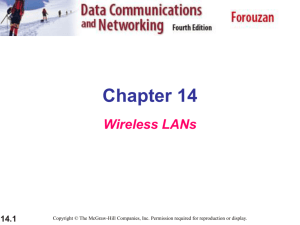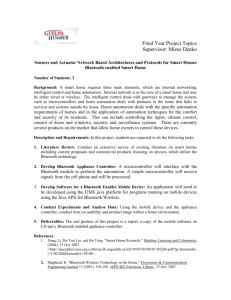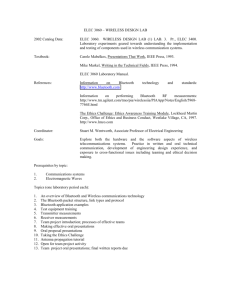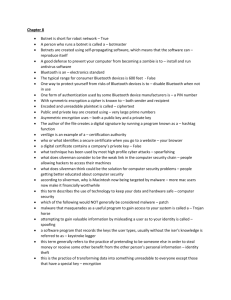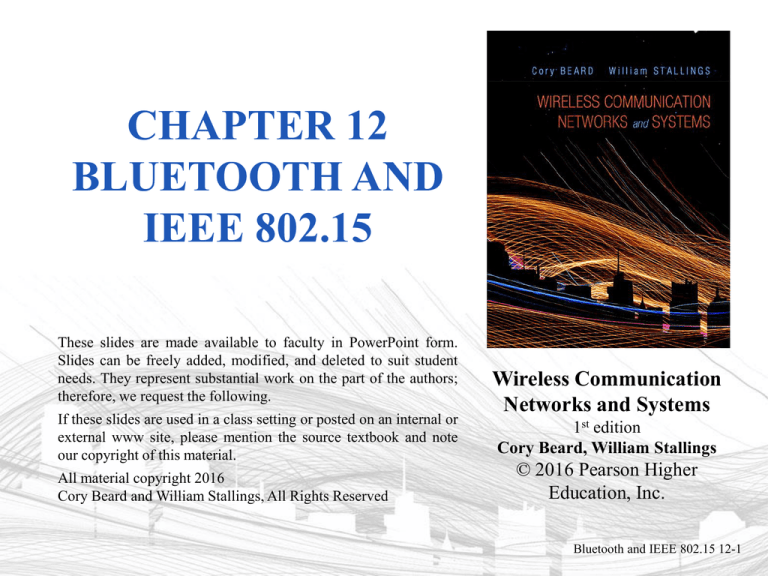
CHAPTER 12
BLUETOOTH AND
IEEE 802.15
These slides are made available to faculty in PowerPoint form.
Slides can be freely added, modified, and deleted to suit student
needs. They represent substantial work on the part of the authors;
therefore, we request the following.
If these slides are used in a class setting or posted on an internal or
external www site, please mention the source textbook and note
our copyright of this material.
All material copyright 2016
Cory Beard and William Stallings, All Rights Reserved
Wireless Communication
Networks and Systems
1st edition
Cory Beard, William Stallings
© 2016 Pearson Higher
Education, Inc.
Bluetooth and IEEE 802.15 12-1
IEEE 802.15
• Wireless Personal Area Networks
– Short-range communication
– Low-cost, low-energy to provide long battery life
• Several standards have been provided
• We focus on 802.15 technologies
– Other viable WPAN alternatives exist
Bluetooth and IEEE 802.15 12-2
INTERNET OF THINGS
• Key application area for short-range communications
• Future Internet
– Large numbers of wirelessly connected objects
– Interactions between the physical world and computing, digital
content, analysis, and services.
– Called the Internet of Things
• And many other “Internet of …” titles
– Useful for health and fitness, healthcare, home monitoring and
automation, energy savings, farming, environmental monitoring,
security, surveillance, education, and many others.
• Machine-to-machine communications (MTM, M2M, D2D,
etc.), also machine-type communications (MTC)
– Devices working together for data analysis and automated
control
Bluetooth and IEEE 802.15 12-3
BLUETOOTH
•
•
•
•
Universal short-range wireless capability
Uses 2.4-GHz band
Available globally for unlicensed users
Devices within 10 m can share up to 2.1 Mbps or 24
Mbps of capacity
• Supports open-ended list of applications
– Data, audio, graphics, video
• Started as IEEE 802.15.1
– New standards come from the Bluetooth Special Interest
Group (Bluetooth SIG)
• Industry consortium
– Bluetooth 2.0, 2.1, 3.0, and 4.0
Bluetooth and IEEE 802.15 12-4
BLUETOOTH APPLICATION AREAS
• Data and voice access points
– Real-time voice and data transmissions
• Cable replacement
– Eliminates need for numerous cable attachments
for connection
• Ad hoc networking
– Device with Bluetooth radio can establish
connection with another when in range
Bluetooth and IEEE 802.15 12-5
TOP USES OF BLUETOOTH
•
•
•
•
•
Mobile handsets
Voice handsets
Stereo headsets and speakers
PCs and tablets
Human interface devices, such as mice and
keyboards
• Wireless controllers for video game consoles
• Cars
• Machine-to-machine applications: credit-card
readers, industrial automation, etc.
Bluetooth and IEEE 802.15 12-6
BLUETOOTH STANDARDS
DOCUMENTS
• Core specifications
– Details of various layers of Bluetooth protocol
architecture
• Profile specifications
– Use of Bluetooth technology to support various
applications
• We first focus on
– 2.1 Basic/Enhanced Data Rate (BR/EDR)
• Later standards
– 3.0 Alternative MAC/PHY (AMP)
– 4.0 Bluetooth Smart (Bluetooth Low Energy)
Bluetooth and IEEE 802.15 12-7
12.1 BLUETOOTH PROTOCOL STACK
Bluetooth and IEEE 802.15 12-8
PROTOCOL ARCHITECTURE
• Bluetooth is a layered protocol architecture
– Core protocols
– Cable replacement and telephony control protocols
– Adopted protocols
• Core protocols
–
–
–
–
–
Radio
Baseband
Link manager protocol (LMP)
Logical link control and adaptation protocol (L2CAP)
Service discovery protocol (SDP)
Bluetooth and IEEE 802.15 12-9
PROTOCOL ARCHITECTURE
• Cable replacement protocol
– RFCOMM
• Telephony control protocol
– Telephony control specification – binary (TCS BIN)
• Adopted protocols
–
–
–
–
PPP
TCP/UDP/IP
OBEX
WAE/WAP
Bluetooth and IEEE 802.15 12-10
PROFILES
• Over 40 different profiles are defined in Bluetooth
documents
– Only subsets of Bluetooth protocols are required
– Reduces costs of specialized devices
• All Bluetooth nodes support the Generic Access Profile
• Profiles may depend on other profiles
– Example: File Transfer Profile
• Transfer of directories, files, documents, images, and streaming
media formats
• Depends on the Generic Object File Exchange, Serial Port, and
Generic Access Profiles.
• Interfaces with L2CAP and RFCOMM protocols
Bluetooth and IEEE 802.15 12-11
PICONETS AND SCATTERNETS
• Piconet
– Basic unit of Bluetooth networking
– Master and one to seven slave devices
– Master determines channel and phase
• Scatternet
– Device in one piconet may exist as master or slave in
another piconet
– Allows many devices to share same area
– Makes efficient use of bandwidth
Bluetooth and IEEE 802.15 12-12
12.2 MASTER/SLAVE RELATIONSHIPS
Bluetooth and IEEE 802.15 12-13
12.3 WIRELESS NETWORK CONFIGURATIONS
Bluetooth and IEEE 802.15 12-14
RADIO SPECIFICATION
• Classes of transmitters
– Class 1: Outputs 100 mW for maximum range
• Power control mandatory
• Provides greatest distance
– Class 2: Outputs 2.4 mW at maximum
• Power control optional
– Class 3: Nominal output is 1 mW
• Lowest power
Bluetooth and IEEE 802.15 12-15
FREQUENCY HOPPING IN
BLUETOOTH
• Provides resistance to interference and
multipath effects
• Provides a form of multiple access among colocated devices in different piconets
Bluetooth and IEEE 802.15 12-16
FREQUENCY HOPPING
• Total bandwidth divided into 1MHz physical
channels
• FH occurs by jumping from one channel to another in
pseudorandom sequence
• Hopping sequence shared with all devices on piconet
• Piconet access:
– Bluetooth devices use time division duplex (TDD)
– Access technique is TDMA
– FH-TDD-TDMA
Bluetooth and IEEE 802.15 12-17
9.2 FREQUENCY HOPPING EXAMPLE
Bluetooth and IEEE 802.15 12-18
12.4 FREQUENCY-HOP TIME-DIVISION DUPLEX
Bluetooth and IEEE 802.15 12-19
12.5 EXAMPLES OF MULTISLOT PACKETS
Bluetooth and IEEE 802.15 12-20
PHYSICAL LINKS BETWEEN
MASTER AND SLAVE
• Synchronous connection oriented (SCO)
– Allocates fixed bandwidth between point-to-point connection of
master and slave
– Master maintains link using reserved slots
– Master can support three simultaneous links
• Asynchronous connectionless (ACL)
– Point-to-multipoint link between master and all slaves
– Only single ACL link can exist
• Extended Synchronous connection oriented (eSCO)
– Reserves slots just like SCO
– But these can be asymmetric
– Retransmissions are supported
Bluetooth and IEEE 802.15 12-21
12.6 BLUETOOTH BASEBAND FORMATS
Bluetooth and IEEE 802.15 12-22
BLUETOOTH PACKET FIELDS
• Access code – used for timing
synchronization, offset compensation, paging,
and inquiry
• Header – used to identify packet type and carry
protocol control information
• Payload – contains user voice or data and
payload header, if present
Bluetooth and IEEE 802.15 12-23
TYPES OF ACCESS CODES
• Channel access code (CAC) – identifies a
piconet
• Device access code (DAC) – used for paging
and subsequent responses
• Inquiry access code (IAC) – used for inquiry
purposes
Bluetooth and IEEE 802.15 12-24
PACKET HEADER FIELDS
• AM_ADDR – contains “active mode” address of one
of the slaves
• Type – identifies type of packet
• Flow – 1-bit flow control
• ARQN – 1-bit acknowledgment
• SEQN – 1-bit sequential numbering schemes
• Header error control (HEC) – 8-bit error detection
code
Bluetooth and IEEE 802.15 12-25
PAYLOAD FORMAT
• Payload header
– L_CH field – identifies logical channel
– Flow field – used to control flow at L2CAP level
– Length field – number of bytes of data
• Payload body – contains user data
• CRC – 16-bit CRC code
Bluetooth and IEEE 802.15 12-26
ERROR CORRECTION SCHEMES
• 1/3 rate FEC (forward error correction)
– Used on 18-bit packet header, voice field in HV1
packet
• 2/3 rate FEC
– Used in DM packets, data fields of DV packet,
FHS packet and HV2 packet
• ARQ
– Used with DM and DH packets
Bluetooth and IEEE 802.15 12-27
ARQ SCHEME ELEMENTS
• Error detection – destination detects errors, discards
packets
• Positive acknowledgment – destination returns
positive acknowledgment
• Retransmission after timeout – source retransmits if
packet unacknowledged
• Negative acknowledgment and retransmission –
destination returns negative acknowledgement for
packets with errors, source retransmits
Bluetooth and IEEE 802.15 12-28
12.7 AN EXAMPLE OF RETRANSMISSION OPERATION
Bluetooth and IEEE 802.15 12-29
LOGICAL CHANNELS
•
•
•
•
•
Link control (LC)
Link manager (LM)
User asynchronous (UA)
User isochronous (UI)
Use synchronous (US)
Bluetooth and IEEE 802.15 12-30
LINK MANAGER
• Manages various aspects of the radio link between a
master and a slave
• Involves the exchange LMP PDUs (protocol data units)
• Procedures defined for LMP are grouped into 24
functional areas, which include
–
–
–
–
–
–
–
Authentication
Pairing
Encryption
Clock offset request
Switch master/slave
Name request
Hold or park or sniff mode
Bluetooth and IEEE 802.15 12-31
LOGICAL LINK CONTROL AND
ADAPTATION PROTOCOL (L2CAP)
• Provides a link-layer protocol between entities with a
number of services
• Relies on lower layer for flow and error control
• Makes use of ACL links, does not support SCO links
• Provides two alternative services to upper-layer
protocols
– Connection service
– Connection-mode service
Bluetooth and IEEE 802.15 12-32
L2CAP LOGICAL CHANNELS
• Connectionless
– Supports connectionless service
– Each channel is unidirectional
– Used from master to multiple slaves
• Connection-oriented
– Supports connection-oriented service
– Each channel is bidirectional
• Signaling
– Provides for exchange of signaling messages between
L2CAP entities
Bluetooth and IEEE 802.15 12-33
FLOW SPECIFICATION
PARAMETERS
•
•
•
•
•
•
Service type
Token rate (bytes/second)
Token bucket size (bytes)
Peak bandwidth (bytes/second)
Latency (microseconds)
Delay variation (microseconds)
Bluetooth and IEEE 802.15 12-34
12.8 TOKEN BUCKET SCHEME
Bluetooth and IEEE 802.15 12-35
BLUETOOTH HIGH SPEED
• Bluetooth 3.0+HS
• Up to 24 Mbps
• New controller compliant with 2007 version of
IEEE 802.11
• Known as Alternative MAC/PHY (AMP)
– Optional capability
• Bluetooth radio still used for device discovery,
association, setup, etc.
• Allows more power efficient Bluetooth modes to
be used, except when higher data rates are needed
Bluetooth and IEEE 802.15 12-36
BLUETOOTH SMART
•
•
•
•
Bluetooth 4.0
Previously known as Bluetooth Low Energy
An intelligent, power-friendly version of Bluetooth
Can run long periods of time on a single battery
– Or scavenge for energy
• Also communicates with other Bluetooth-enabled devices
– Legacy Bluetooth devices or Bluetooth-enabled smartphones
– Great feature
• Possible successful technology for the Internet of Things
– For example, health monitoring devices can easily integrate with
existing smartphones
Bluetooth and IEEE 802.15 12-37
BLUETOOTH SMART
• Same 2.4 GHz ISM bands as Bluetooth BR/EDR
– But uses 40 channels spaced 2 MHz apart instead of 79
channels spaced 1 MHz apart
• Devices can implement a transmitter, a receiver, or both
• Implementation
– Single-mode Bluetooth Smart functionality
• Reduced cost chips that can be integrated into compact devices.
– Dual-mode functionality to also have the Bluetooth
BR/EDR capability
• 10 mW output power
• 150 m range in an open field
Bluetooth and IEEE 802.15 12-38
IEEE 802.15
• After 802.15.1, work went two directions
• 802.15.3
– Higher data rates than 802.15.1
– But still low cost, low power compared to 802.11
• 802.15.4
– Very low cost, very low power compared to
802.15.1
• Figure 12.9 shows different options
• Figure 12.10 shows relative distances and rates
Bluetooth and IEEE 802.15 12-39
12.9 IEEE 802.15 PROTOCOL ARCHITECTURE
Bluetooth and IEEE 802.15 12-40
12.10 WIRELESS LOCAL NETWORKS
Bluetooth and IEEE 802.15 12-41
12.11 ZIGBEE ARCHITECTURE
Bluetooth and IEEE 802.15 12-42
IEEE 802.15.3
• High data rate WPANs
– Digital cameras, speakers, video, music
• Piconet coordinator (PNC)
–
–
–
–
Sends beacons to devices to connect to the network
Uses superframes like 802.11
QoS based on TDMA
Controls time resources but does not exchange data
• 802.15.3c
– Latest standard
– Uses 60 GHz band, with same benefits as 802.11ad
– Single-carrier and OFDM PHY modes
Bluetooth and IEEE 802.15 12-43
IEEE 802.15.4
• Low data rate, low complexity
– Competitor to Bluetooth Smart
• PHY options in 802.15.4 and 802.15.4a
– 868/915 MHz for 20, 40, 100, and 250 kbps
– 2.4 GHz for 250 kbps
– Ultrawideband (UWB)
• Uses very short pulses with wide bandwidth
– Low energy density for low interference with others
• 851 kbps and optionally 110 kbps, 6.81 Mbps, or 27.234 Mbps
– 2.4 GHz chirp spread spectrum for 1 Mbps and optionally
250 kbps
• Sinusoidal signals that change frequency with time
Bluetooth and IEEE 802.15 12-44
IEEE 802.15.4
• Many other creative and practical activities
• IEEE 802.15.4f – Active Radio Frequency Identification Tags
(RFIDs)
– Attached to an asset or person with a unique identification
– An Active RFID tag must employ some source of power
• IEEE 802.15.4g – Smart Utility Networks (SUN)
– Facilitates very large scale process control applications such as the
utility smart-grid network
• IEEE 802.15.4j – Medical Body Area Networks
• EEE 802.15.4k – Low Energy Critical Infrastructure Networks
(LECIM)
– To facilitate point to multi-thousands of points communications for
critical infrastructure monitoring devices with multi-year battery life.
• IEEE 802.15.4p – Positive Train Control
– Sensor, control and information transfer applications for rail transit
Bluetooth and IEEE 802.15 12-45
OTHER IEEE 802.15 STANDARDS
• 802.15.2 – Coexistence between 802.11 and
802.15
• 802.15.5 – Mesh networks
– Multihop networking
• 802.15.6 – Body area networks
• 802.15.7 – Visible light communication
Bluetooth and IEEE 802.15 12-46
ZIGBEE
• Extends IEEE 802.15.4 standards
• Low data rate, long battery life, secure
networking
• Data rates 20 to 250 kbps
• Operates in ISM bands
– 868 MHz (Europe), 915 MHz (USA and Australia), 2.4
GHz (worldwide)
• Quick wake from sleep
– 30 ms or less compared to Bluetooth which can be up
to 3 sec.
– ZigBee nodes can sleep most of the time
Bluetooth and IEEE 802.15 12-47
ZIGBEE
• ZigBee complements the IEEE 802.15.4
standard by adding four main components
– Network layer provides routing
– Application support sublayer supports specialized
services.
– ZigBee device objects (ZDOs) are the most
significant improvement
• Keep device roles, manage requests to join the network,
discover devices, and manage security.
– Manufacturer-defined application objects allow
customization.
Bluetooth and IEEE 802.15 12-48
12.11 ZIGBEE ARCHITECTURE
Bluetooth and IEEE 802.15 12-49
ZIGBEE
• Star, tree, or general mesh network structures
• ZigBee Coordinator
– Creates, controls, and maintains the network
– Only one coordinator in the network
– Maintains network information, such as security keys
• ZigBee Router
– Can pass data to other ZigBee devices
• ZigBee End Device
–
–
–
–
Only enough functionality to talk to a router or coordinator
Cannot relay information
Sleeps most of the time
Less expensive to manufacture
Bluetooth and IEEE 802.15 12-50
12.12 ZIGBEE NETWORK
Bluetooth and IEEE 802.15 12-51
ZIGBEE ALLIANCE
• Industry consortium
• Maintains and publishes the ZigBee standard
– ZigBee specifications in 2004
– ZigBee PRO completed in 2007
• Enhanced ZigBee
• Profile 1 – home and light commercial use
• Profile 2 – more features such as multicasting and higher
security
• Application profiles
– Allow vendors to create interoperable products if they
implement the same profile
Bluetooth and IEEE 802.15 12-52
ZIGBEE APPLICATION PROFILES
•
•
•
•
•
•
•
•
•
•
•
ZigBee Building Automation (Efficient commercial spaces)
ZigBee Health Care (Health and fitness monitoring)
ZigBee Home Automation (Smart homes)
ZigBee Input Device (Easy-to-use touchpads, mice, keyboards,
wands)
ZigBee Light Link (LED lighting control)
ZigBee Network Devices (Assist and expand ZigBee networks)
ZigBee Retail Services (Smarter shopping)
ZigBee Remote Control (Advanced remote controls)
ZigBee Smart Energy 1.1 (Home energy savings)
ZigBee Smart Energy Profile 2 (IP-based home energy
management)
ZigBee Telecom Services (Value-added services)
Bluetooth and IEEE 802.15 12-53


